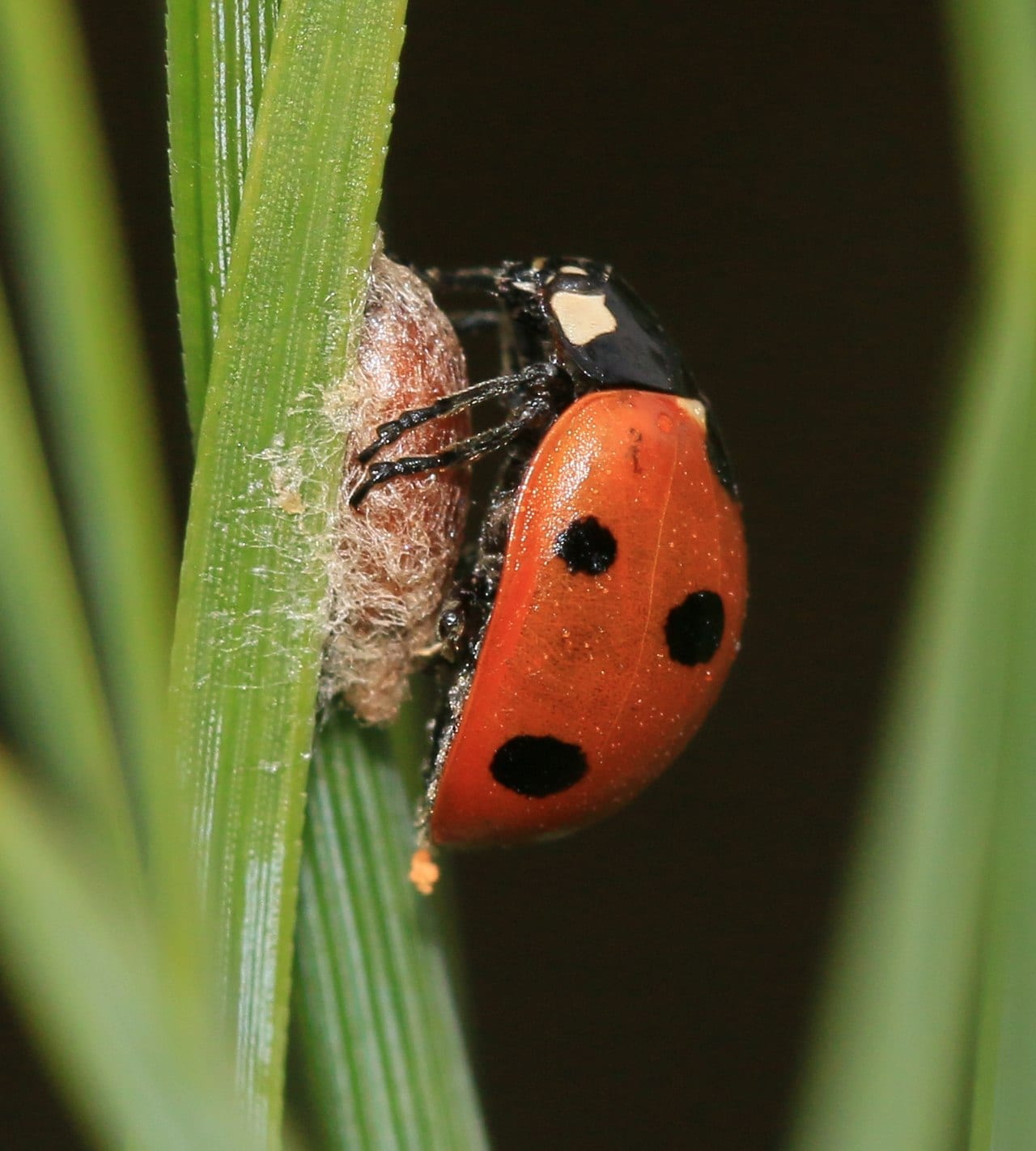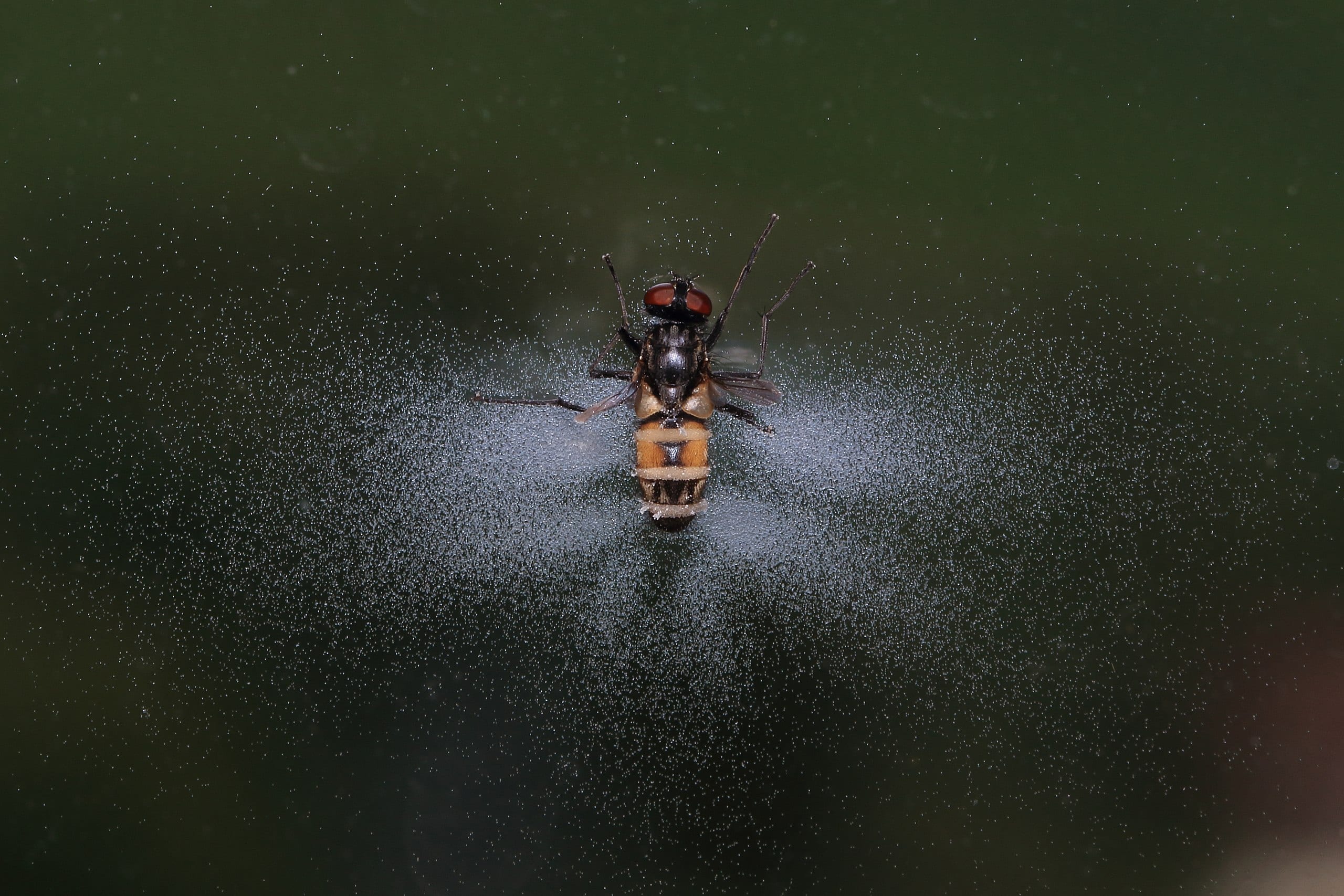In July of 2018, the Eisen lab at UC Berkeley published what Michael Eisen described as one of the wackiest discoveries of his career. They discovered a virus that swapped hosts from a fly to a fungus. This virus might underlie the fungus' ability to control the minds of insects.
Since the 1850s, people have noted that flies that have become infected by this fungus exhibit strange behavior. Around dusk, they will climb to a treetop position and stick out their proboscis as though they are lapping up food, but instead the proboscis adheres to the surface thanks to a sticky substance that the fungus secretes. The wings rise up like the doors of a Lamborghini and provide launch pads for the spores. The fungus replicates so much that the spores are forcibly ejected from cracks in the insect cuticle to fall onto and infect other flies. If you were to cut one open near the end of the fungal replication cycle, you would mostly only find fungus because all of the insect's internal organs will have been dissolved by then; the flies are eaten from the inside out. This fungus is befittingly named Entomophthora muscae, which is Greek for “insect destroyer.â€
The Eisen lab has been working on this behavior manipulating fungal pathogen in the insect Drosophila melanogaster. They're asking questions like: How is it that microbes are convincing animals to behave in these crazy ways to improve their own dispersal? What's behind the scenes here?
Carolyn Elya, then a graduate student in the Eisen lab, spearheaded this project. She was the first researcher to domesticate this fungal pathogen to productively infect lab-reared Drosophila to perpetuate the fungal replication cycle, allowing the lab to study the fungus in full force. Carolyn sequenced the transcriptome of the fungus and strikingly, they found that up to 15% of their RNA didn't belong to their fungus at all, but instead belonged to a virus that lives inside the fungal cells. This offers a good lesson for biologists: when sequencing something, we often assume that it's the only thing we're sequencing, but in many cases there are hitchhikers like this virus.
As it turns out, this virus is very much like those that infect flies in the order Picornavirales. Along with poliovirus, the Dinocampus coccinellae paralysis virus (DcPV) is in this group, and it's capable of infecting the neural tissue of ladybugs. DcPV is transmitted by a wasp, and the virus influences the ladybug to hold a developing wasp pupa between its legs and twitch to ward off predators. The Eisen lab named their fungal virus Entomophthovirus, and while its genetic code looks like sequences from viruses that infect insects, it actually infects a fungus that infects insects. Thus, the Entomophthovirus likely jumped from a fly into a fungus at some point in its evolutionary history. This interkingdom host switch is a dramatic revolution considering animals and fungi diverged evolutionarily about 1.5 billion years ago.

Currently, there's no direct evidence that the virus itself is involved in manipulating the fly's behavior. But if it's true, it might have evolved simply by accident. For instance, other picornaviruses like poliovirus can cause paralysis, but only in about 1 out of every 200 infections. The normal route through the gut causes little pathology, but the virus causes severe neurological symptoms if it accidentally enters the central nervous system. As it turns out, a paralyzed ladybug is great at holding onto wasp pupae, and this behavioral modification by the virus could have initially been an accident that was then selected for. The virus doesn't have to do something complex to alter host behavior for its own benefit: causing something as simple as paralysis in the right environmental setting can actually go really far.
The Eisen lab is still pursuing the question of how these microbes are manipulating their hosts' behavior. Future work might include infecting flies with virus-free fungus, observing their behavior, and then injecting the flies with the virus to see how their behavior might change. Alternative to the hypothesis of mutualistic symbiosis, the virus could be a parasite of the fungus, being a bug in a bug in a bug. Who knows? There are surprises around every corner in the world of insect-microbe symbioses.

About the author:
 Dustin Dial is a Ph.D. student in the Department of Entomology. He studies the symbiotic relationships between microbes and animals using functional and evolutionary genetics and genomics. While not in the lab, you might find him writing music, exploring nature or watching Netflix with his cat, Marilyn. You can contact him at dtdial@uga.edu
Dustin Dial is a Ph.D. student in the Department of Entomology. He studies the symbiotic relationships between microbes and animals using functional and evolutionary genetics and genomics. While not in the lab, you might find him writing music, exploring nature or watching Netflix with his cat, Marilyn. You can contact him at dtdial@uga.edu
About the Author
-
athenssciencecafehttps://athensscienceobserver.com/author/athenssciencecafe/April 17, 2020
-
athenssciencecafehttps://athensscienceobserver.com/author/athenssciencecafe/April 12, 2020
-
athenssciencecafehttps://athensscienceobserver.com/author/athenssciencecafe/April 3, 2020
-
athenssciencecafehttps://athensscienceobserver.com/author/athenssciencecafe/March 30, 2020







